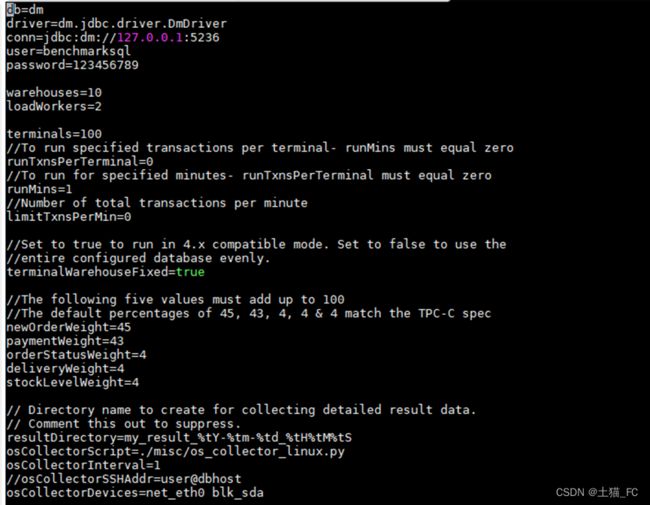学习使用TPC-C测试
一、前言
TPC-C是在线事务处理(OLTP)的基准程序,用于衡量数据库系统OLTP性能的指标。本次TPC-C将会使用到BenchmarkSQL工具
OLTP:On-Line Transaction Processing 联机事务处理,也称为面向交易的处理系统,其基本特征是顾客的原始数据可以立即传送到计算中心进行处理,并在很短的时间内给出处理结果。这样做的最大特点是可以即时地处理输入的数据,及时地回答。所以也称为实时系统。
BenchmarkSQL工具介绍
该工具为开源软件,采用范围更广泛;
基于JAVA语言开发,跨平台运行;
要求JDK1.7及以上运行环境;
非标准TPC-C模型,纯压力测试
BenchmarkSQL使用介绍:
执行SQL工具建表
./runSQL.sh props.dm sqlTableCreates
执行数据装载工具装载数据
./runLoader.sh props.dm numWarehouses 10
执行测试工具
./runBenchmark.sh props.dm
为提高性能,通常采用后台运行的方式
nohup ./runBenchmark.sh props.dm > /dev/null 2>&1 &
测试报告打印在run/log文件下
Benchmarksql.log
| C_ITEM |
商品种类:固定值 |
100K |
| C_WAREHOUSE |
仓库数 |
W |
| C_STOCK |
库存数=仓库数*商品种类 |
W*100K |
| C_DISTRICT |
分区数=仓库数*10 |
W*10 |
| C_CUSTOMER |
客户数=分区数*3000 |
W*30K |
| C_ORDER |
订单数=客户数 |
W*30K+ |
| C_HISTORY |
订单数=客户数 |
W*30K+ |
| C_NEW_ORDER |
新订单数=订单数*900/3000 |
W*9K+ |
| C_ORDER_LINE |
订单行数=订单数*10*0.99... |
W*300K+ |
二、环境准备
操作系统:redhat 7.5 x86_64
服务器配置:2核4G
磁盘50G
数据库版本:DM8开发版
benchmarksql版本:benchmarksql-5.0rc2-westone-v1.2
JAVA版本:18.0.1.1
三、正式安装与使用
1.将BenchmarkSQL工具传输到服务上
2.解压
cd /opt/tmp
tar -zxvf bms.tar.gz
3.使用sql语句建表
CREATE TABLESPACE BENCHMARKSQL1 DATAFILE 'BENCHMARKSQL1.dbf' SIZE 20000;
CREATE USER "BENCHMARKSQL" IDENTIFIED BY "123456789" DEFAULT TABLESPACE "BENCHMARKSQL1";
GRANT DBA TO BENCHMARKSQL;
alter tablespace "ROLL" resize datafile 'ROLL.DBF' to 1000;
alter database resize logfile 'DAMENG01.log' to 4000;
alter database resize logfile 'DAMENG02.log' to 4000;
create table BENCHMARKSQL.bmsql_config (
cfg_name varchar(30) cluster primary key,
cfg_value varchar(50)
);
create table BENCHMARKSQL.bmsql_warehouse (
w_id integer not null,
w_ytd decimal(22,2),
w_tax float,
w_name varchar(10),
w_street_1 varchar(20),
w_street_2 varchar(20),
w_city varchar(20),
w_state char(2),
w_zip char(9),
cluster primary key(w_id)
)STORAGE(FILLFACTOR 1);
create table BENCHMARKSQL.bmsql_district (
d_w_id integer not null,
d_id integer not null,
d_ytd decimal(22,2),
d_tax float,
d_next_o_id integer,
d_name varchar(10),
d_street_1 varchar(20),
d_street_2 varchar(20),
d_city varchar(20),
d_state char(2),
d_zip char(9),
cluster primary key(d_w_id, d_id)
)STORAGE(FILLFACTOR 1);
create table BENCHMARKSQL.bmsql_customer (
c_w_id integer not null,
c_d_id integer not null,
c_id integer not null,
c_discount float,
c_credit char(2),
c_last varchar(16),
c_first varchar(16),
c_credit_lim float,
c_balance float,
c_ytd_payment float,
c_payment_cnt integer,
c_delivery_cnt integer,
c_street_1 varchar(20),
c_street_2 varchar(20),
c_city varchar(20),
c_state char(2),
c_zip char(9),
c_phone char(16),
c_since timestamp,
c_middle char(2),
c_data varchar(500),
cluster primary key(c_w_id, c_d_id, c_id)
);
create table BENCHMARKSQL.bmsql_history (
hist_id integer,
h_c_id integer,
h_c_d_id integer,
h_c_w_id integer,
h_d_id integer,
h_w_id integer,
h_date timestamp,
h_amount float,
h_data varchar(24)
)storage(branch(32,32),without counter);
create table BENCHMARKSQL.bmsql_oorder (
o_w_id integer not null,
o_d_id integer not null,
o_id integer not null,
o_c_id integer,
o_carrier_id integer,
o_ol_cnt float,
o_all_local float,
o_entry_d timestamp,
cluster primary key(o_w_id, o_d_id, o_id)
)storage(without counter);
create table BENCHMARKSQL.bmsql_new_order (
no_w_id integer not null,
no_d_id integer not null,
no_o_id integer not null,
cluster primary key(no_w_id, no_d_id, no_o_id)
)storage(without counter);
create table BENCHMARKSQL.bmsql_order_line (
ol_w_id integer not null,
ol_d_id integer not null,
ol_o_id integer not null,
ol_number integer not null,
ol_i_id integer not null,
ol_delivery_d timestamp,
ol_amount float,
ol_supply_w_id integer,
ol_quantity float,
ol_dist_info char(24),
cluster primary key(ol_w_id, ol_d_id, ol_o_id, ol_number)
)storage(without counter);
create table BENCHMARKSQL.bmsql_stock (
s_w_id integer not null,
s_i_id integer not null,
s_quantity float,
s_ytd float,
s_order_cnt integer,
s_remote_cnt integer,
s_data varchar(50),
s_dist_01 char(24),
s_dist_02 char(24),
s_dist_03 char(24),
s_dist_04 char(24),
s_dist_05 char(24),
s_dist_06 char(24),
s_dist_07 char(24),
s_dist_08 char(24),
s_dist_09 char(24),
s_dist_10 char(24),
cluster primary key(s_w_id, s_i_id)
);
create table BENCHMARKSQL.bmsql_item (
i_id integer not null,
i_name varchar(24),
i_price float,
i_data varchar(50),
i_im_id integer,
cluster primary key(i_id)
);
4.查看配置文件
vi props.dm
其中warehouses是被测仓库数
Loadworkers是数据装载并发数
Terminals是数据库连接并发数
runMins是测试时间(分钟)
因为是自己电脑上的虚拟机,所以选择的参数都偏小
Warehouses=10
Loadworkers=2
runMins=1
5. 执行数据装载工具装载数据
./runLoader.sh props.dm numWarehouses 10
装载数据完毕后查看下表内数据
select count(*) from BENCHMARKSQL.bmsql_config union all
select count(*) from BENCHMARKSQL.bmsql_warehouse union all
select count(*) from BENCHMARKSQL.bmsql_district union all
select count(*) from BENCHMARKSQL.bmsql_customer union all
select count(*) from BENCHMARKSQL.bmsql_history union all
select count(*) from BENCHMARKSQL.bmsql_oorder union all
select count(*) from BENCHMARKSQL.bmsql_new_order union all
select count(*) from BENCHMARKSQL.bmsql_order_line union all
select count(*) from BENCHMARKSQL.bmsql_stock union all
select count(*) from BENCHMARKSQL.bmsql_item;
6.执行测试工具
./runBenchmark.sh props.dm
也可以采用后台的方式运行
nohup ./runBenchmark.sh props.dm > /dev/null 2>&1 &
7.建立索引
create index ndx_customer_name on BENCHMARKSQL.BMSQL_customer (c_w_id, c_d_id, c_last, c_first);
create or replace procedure BENCHMARKSQL.createsequence
as
n int;
stmt1 varchar(200);
begin
select count(*)+1 into n from BMSQL_history;
if(n != 1) then
select max(hist_id) + 1 into n from BMSQL_history;
end if;
PRINT n;
stmt1:='create sequence hist_id_seq start with '||n||' MAXVALUE 9223372036854775807 CACHE 50000;';
EXECUTE IMMEDIATE stmt1;
end;
/
call BENCHMARKSQL.createsequence;
alter table BENCHMARKSQL.BMSQL_history modify hist_id integer default (BENCHMARKSQL.hist_id_seq.nextval);
8.查看bmsql_history表
select count(*) from BENCHMARKSQL.bmsql_history;
发现数据增加了16448条,transaction count * 43% 约等于 bmsql_history 表增加的数据量。
查看TPCC基准测试一致性验证语句
(Select w_id, w_ytd from BENCHMARKSQL.bmsql_warehouse) except(select d_w_id, sum(d_ytd) from BENCHMARKSQL.bmsql_district group by d_w_id);
(Select d_w_id, d_id, D_NEXT_O_ID - 1 from BENCHMARKSQL.bmsql_district) except (select o_w_id, o_d_id, max(o_id) from BENCHMARKSQL.bmsql_oorder group by o_w_id, o_d_id);
(Select d_w_id, d_id, D_NEXT_O_ID - 1 from BENCHMARKSQL.bmsql_district) except (select no_w_id, no_d_id, max(no_o_id) from BENCHMARKSQL.bmsql_new_order group by no_w_id, no_d_id);
select * from (select (count(no_o_id)-(max(no_o_id)-min(no_o_id)+1)) as diff from BENCHMARKSQL.bmsql_new_order group by no_w_id, no_d_id) where diff != 0;
(select o_w_id, o_d_id, sum(o_ol_cnt) from BENCHMARKSQL.bmsql_oorder group by o_w_id, o_d_id) except (select ol_w_id, ol_d_id, count(ol_o_id) from BENCHMARKSQL.bmsql_order_line group by ol_w_id, ol_d_id);
(select d_w_id, sum(d_ytd) from BENCHMARKSQL.bmsql_district group by d_w_id) except(Select w_id, w_ytd from BENCHMARKSQL.bmsql_warehouse);
如果结果全为0行,则说明tpcc库是一致的,否则说明此库在运行过程中数据出现混乱。
四、后记
可以将磁盘尽量扩大点,第一次因为磁盘太小导致在数据装载时失败,如果文中哪里有误,欢迎指出,大家共同交流进步!
社区地址:https://eco.dameng.com




